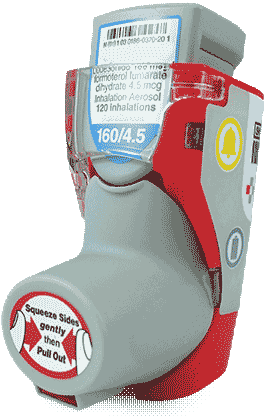Types Of Inhalers For Asthma
Over The Counter Asthma Inhalers
The therapy of asthma is basically carried out by two types of medications with their own purpose each. The aim of the first group is to put the disease under control in the long run, to minimize its negative consequences and to enable a person suffering from asthma to keep a normal, active way of life. This group of drugs is called Long-Term Control Medications. Their action is based on reducing inflammation in the airways and making them less likely to react to triggers. This is the most important type of medicines for patients with asthma. These drugs are taken regularly with fixed intervals; for example, daily once a day. They are taken even when the patient doesn’t have any symptoms. This group can be subdivided into the following pharmaceutical forms: inhaled corticosteroids, leukotriene modifiers, long-acting beta agonists (LABAs), theophylline and combination inhalers that contain both a corticosteroid and a LABA.
Preparations of the second group, so called rescue medications, bring a quick relief in case of an asthma attack. They cut off a spasm by relaxing the muscles around your respiratory tracts. Normally, they are used rarely: once or twice per week; if you have to use them more often, you should consult your doctor. This group includes short-acting beta agonists such as albuterol, ipratropium (Atrovent) and oral and intravenous corticosteroids (for cutting asthma attacks).
Please have in mind that the types and doses of drugs may vary for different groups of patients with the same diagnosis of asthma. The required treatment depends on the age, symptoms, the severity of asthma and possible allergic reactions. Since the symptoms of asthma can change over time, be in close contact with your doctor to track your condition and adjust medications if needed.
Medications for allergy-induced asthma can also be considered as a separate group. They can be taken regularly or when necessary to reduce the sensitivity to a particular allergy-causing substance (allergen).
Preparations of the all main groups are often produced in the form of spray canisters.
Inhaled corticosteroid medications
These drugs belong to the long-term control anti-inflammatory medications group. Nowadays, they are the most effective and commonly used preparations for asthma. They reduce swelling and tightening in your airways. Their effect is not immediate; to have a well-pronounced benefit, you may need to use them for several months.
Inhaled corticosteroids include the following:
- Fluticasone
- Budesonide
- Mometasone
Generally, they are not recommended for children: long-term use of them can delay growth slightly. However, the benefits of using these medications often outweigh possible risks. Regular use of inhaled corticosteroids helps maintain asthma attacks and other related problems under control.
Regarding the side effects for adult patients, they are not generally serious for inhaled corticosteroids. Possible side effects most often include mouth and throat irritation and oral yeast infections. Side effects can be minimized by simple rinsing your mouth with water after each use to reduce the amount of drug that can be absorbed by your body.
Long-acting beta agonists (LABAs)
These medications dilate your airways and reduce asthma symptoms for 10 to 12 hours. They belong to the Long-Term Control Medications group, and they should be used on the regular basis to control moderate to severe asthma. LABAs especially effective at defeating severe asthma attacks if they are taken together with some inhaled corticosteroid.
Examples of LABAs include such preparations as
- Salmeterol (Serevent)
- Formoterol (Foradil, Perforomist)
Leukotriene modifiers
The medications of this group block the action of so called leukotrienes, i.e. chemicals in our immune system that can provoke an attack of asthma.
These medication include such preparations as
- Montelukast (Singulair)
- Zafirlukast (Accolate)
- Zileuton (Zyflo)
Sometimes, montelukast can provoke psychological disturbances like agitation, aggression, hallucinations, depression and even suicidal thoughts. Consult your physician promptly if you have any of such reactions.
Theophylline
This is a bronchodilator taken daily in pill form. It is used to control mild forms of asthma. Theophylline relaxes the lung’s airways; it is especially helpful for reducing nighttime asthma symptoms. The correct dose can be defined only by regular blood tests.
Possible side effects include insomnia and gastroesophageal reflux.

